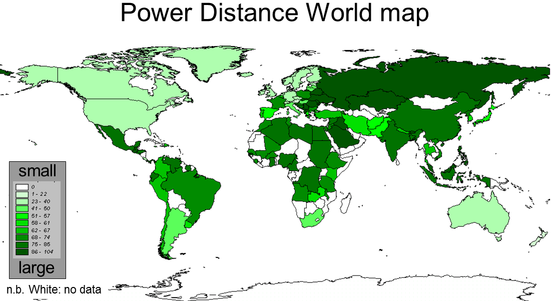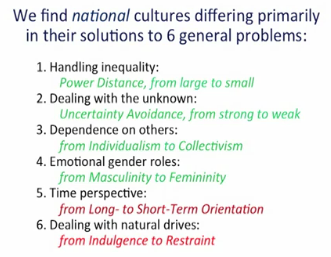Archive for the ‘Hofstede’ Category
Cultural Aspects of Information Management in China
Cultural Aspects of Information Management in China (Abstract)
Collectivistic Background
Chinese culture is a collectivist culture which stresses the interdependence and long-term mutual obligations between individuals and organizations. People are expected to follow group values and initiatives. As found in the study of western ecommerce diffusion in China, Chinese people prefer small group based operations with emphasis on long-term relationship, interorganizational collaboration and re-negotiation. Another ecommerce study also indicates that collectivist features like clubs, chat rooms and family themes have a higher percentage occurrence on Chinese websites than on US domestic websites.
Chinese collectivism, however, differs substantially from those prevailing in other Asian countries. They are individualistic collectivism where small group or family value is emphasized, rather than society oriented. In contrast to Japanese society, which may be considered as a block of granite, the Chinese resembles a tray of loose sand, where every grain is a family.
This opinion is consistent with the finding of Martinsons and Westwood (1997) that the Chinese power structure is perhaps best represented by a series of concentric circles or “family” with the patriarch in the center. The traditional family values are emphasized in this circle. The Chinese collectivism can be either an inhibitor or enabler of IS practices. Most information is gathered and processed in Chinese environment is intended to support the top managers of various small circles, which results in many independent systems and data that are hard to integrate or share. Such behaviors actually make Chinese collectivism a negative factor in ERP implementation. From above analysis, Chinese collectivism may be seen as individualistic collectivism.
Hierarchical Power Structure
Chinese management philosophy is characterized by centralized authorities as well as directive and hierarchical structures due to the long power distance and paternalistic tendency. The position of top management in Chinese business is overwhelming. No other champion is needed because such a champion would be seen as a challenge to the authority of top management, which often leads to power conflicts. And both top managers and lower level staffs are not comfortable with empowerment because they are accustomed to the practice that key decisions are made by top management. It is also natural that Chinese business leaders use their authorities to facilitate modifying subordinates behaviors in change management.
Unfortunately, Chinese top managers do not appear to realize the importance of IT and IT management. Consequently, they commit less on IT management. Problem arise when Chinese managers rarely accept knowledge input from their subordinates, and when the IT decisions by top management are seldom made with due consultation with end users This may be helpful to speed up IT decision and IT implementation, but such bureaucratic and arbitrary organizational culture is seen as one important cause of IT project failures.
The hierarchy management structure also helps to explain the correlation between power and information in China. Information control is one of the predominant sources of power in China. Critical information in China is selectively preserved instead of being distributed widely. Information is often treated as an individual property and critical information controlled by individual can be used to preserve discretionary power in Chinese organization. It is quite obvious in e-government practices in China where branches of government purposely hold back some information and obstruct large-scale information sharing in order to keep their power and interests.
Uncertainty Tolerance
Uncertainty tolerance is the extent a person feels comfortable in unstructured situations. It is commonly accepted that there are two different cultures, namely, uncertainty avoiding culture and uncertainty accepting culture.
The former tries to minimize uncertainly by taking strict laws and regulations, or risk control measures. The later tolerates ambiguous situation, and tries to live peacefully with it.
The majority of the studies, however, argue that the Chinese culture is uncertainty tolerant. Martinsons (1997) and Lam et al(2005) show that East Asians, especially Chinese people are more comfortable with unclear information. This corresponds with the informal communication path among Chinese that relies more on personal experience. They keep more information among themselves, rather than explicitly express it. It is common in China that you need to guess the “true” meaning of conversation beside the surface information, because Chinese people like to use allusion to tell something they think you should know and would understand.
Based on authors’ own understanding about uncertainty tolerance as native Chinese, the uncertainty avoidance mentioned in the literature is mainly because of the importance of information for the power, rather than unable to tolerate the uncertainty. So the idea that Chinese culture is uncertainty tolerant is supported. Contrary to the traditional thinking that Chinese people are more conservative in regard to change, the literature demonstrates that Chinese people’s attitude seems to be more positive toward change and towards new technology when they come to experience it.
Both Collis (1995) and Brown et al(1998) conclude that people from China hold more positive attitudes on change and new technologies than those from countries that they compare, namely, UK, US and Japan.
Intuitive Decision Making
The way that Chinese people make decisions or solve problems is relatively unstructured compared with westerners “the Chinese’s decisions are comparatively implicit, relying on analogical and correlative thinking, rather than on rational and analytic thinking”. Although Chinese managers refer to information or data to support decision making process, only a few data analysis is used even when deciding the most important issues.
The entrepreneurial model of strategy making that relies on personal knowledge and intuition rather than objective criteria or formal and quantitative method is dominant in Chinese decision making. Therefore, “the decision making process usually involves few people and takes short time to make”.
The decision making of Chinese people is also characterized to be highly contextual. Regulation and rules may play important role in directing the decision, but in most situations, Chinese people like to adopt “the individual-policy-for-individual-issue approach”, which means that the executors of rules usually can find some room for themselves to make flexible decisions.
Cultural Aspects of IS in China
Xiang-Hua Lu / School of Management, Fudan University
Michael S H Heng / National University of Singapore
Download the full pdf here.
The PACIS (Pacific Asia Conference on IT Systems) has tons of other interesting material and is worth a visit.
.
The I Ging – structure in East Asian Collectives (Natural Order)
This Matrix defines the Relationship Layer (Ranking/Relation) and the Appeal Layer (Distance/Approach). Still many Asian companies follow this structure.
.
Download an introduction to Hofstede`s theories as pdf here.
.
Genetics, Cultures and Happiness
Genetics, Cultures and Happiness / 5-HTTLPR
Joan Chiao and Katherine Blisinsky took a research on the worldwide spreading of the 5-HTTLPR – gene, which is identified as responsible for the mood (anxiety and mood disorder) of it`s carrier by transporting serotonin. It was published from the Royal Society Publishing.
Using Hofstede`s model of cultural indices/dimensions to define cultures into individualistic and collectivistic, they crossed these data with the spreading of 5-HTTLPR.
(…) Here, we demonstrate for the first time a robust association between cultural values of individualism–collectivism and allelic frequency of the serotonin transporter gene, controlling for associated economic and disease factors. (…) Critically, our results further indicate that greater population frequency of S allele carriers is associated with decreased prevalence of anxiety and mood disorders due to increased cultural collectivism. (…)
.
Results from correlation analysis between Hofstede’s individualism–collectivism index (reverse scored) and frequency of S allele carriers of the 5-HTTLPR across 29 nations. Collectivist nations showed higher prevalence of S allele carriers (r(29) = 0.70, p < 0.0001).
Geographical coincidence between serotonin transporter gene diversity and cultural traits of individualism–collectivism across countries. Colour maps include all available published data for each variable of interest. Grey areas indicate geographical regions where no published data are available. (a ) Hofstede Colour map of frequency distribution of IND-COL from Hofstede (2001). (b) 5-HTTLPR Colour map of frequency distribution of S alleles of 5-HTTLPR. (c) anxiety Colour map of frequency of global prevalence of anxiety. (d) mood disorders Colour map of frequency of global prevalence of mood disorders. Yellow to red colour bar indicates low to high prevalence.
Get the full article online here or download pdf here. It is packed with additional downloads.
(Chiao, J.Y. & Blizinsky, K.D. 2009 Culture-gene coevolution of individualism-collectivism and the serotonin transporter gene. Proc. R. Soc. B (doi: 10.1098/rspb.2009.1650)
(retrieved 20.05.2015 at http://rspb.royalsocietypublishing.org/content/277/1681/529.full)
Hofstede`s Intercultural Tool is found here.
.
Background Info: World`s Haplogroups
This Map of Haplogroups (J.D. McDonald) shows the distribution of certain genetic characteristics. It is widely used for genealogical research because certain cell structures are inherited matrilinear or patrilinear. Click here to download from the the University of Illinois/School of Chemical Sciences. You can also download the full pdf here.
(retrieved 20.05.2015 at http://www.scs.uiuc.edu/%7Emcdonald/WorldHaplogroupsMaps.pdf)
~
Additional Material
Happiness and Income
.
From R.Inglehart and H-D.Klingemann, “Genes, Culture and Happiness,” MIT Press, 2000.Check out for more at http://www.worldvaluessurvey.org/
.
Read a different view on the categories “Cultures and Genes” and “Culture influences Brain” or view the World’s Map of Happiness.
.
(reviewed 21.05.2015)
Hofstede`s Cultural Onion
Gerard (Geert) Hendrik Hofstede (born 3 October 1928) created the model of the „Cultural Onion“
Unfortunately, the nice intercultural website where I got the pic from was closed down: http://homepages.rtlnet.de/krkarwoth/priorities.html (retrieved 28.08.2009, disappearance noticed 22.11.2012). Sorry for this.
It is made of 3 layers around a core. The core stands for the values of a certain culture, which is not moving a lot. It mostly remains the same. Even if something seems to be outdated, it still can subconsciously play a role in the present. That includes individuals as well as groups.
~
The first layer around the core is described as rituals. A ritual can be the way of personal hygiene (most Asians shower in the evening, Europeans in the morning). German people like to shake hands often, Malay tenderly touch the fingertips and then point it to the heart. Those rituals are changing slowly.
~
The second layer around the core are the „heroes“. A hero can be a fictive person, but has influence on the culture. A nice example is Dracula (written by Bram Stoker, published 1897). Since this book was published, many people in Western world developed a fear about Vampires, even if it never existed in their culture before. It also can be national heroes, photo-models or scientists – all people, who play a role-model in that society.
~
The third layer is about the symbols. Nowadays most symbols appear as brands like BMW, Apple or Louis Vuitton. Those symbols usually move according to the momentary fashion.
~
All three layers can be trained and learned through practices except for the core: the inner cultural values (Good vs. Bad, dirty vs. clean, ugly vs. beautiful, unnatural vs. natural, abnormal vs. normal, paradoxical vs. logical, irrational vs. rational).
For further information about the core, please refer to The Core of Hofstede’s Onion Model.
~
Hofstede also developed the Model of the 5 Cultural Dimensions https://laofutze.wordpress.com/2010/01/09/hofstedes-cultural-dimensions-2/
Download an introduction to Hofstede`s theories as pdf here or see further info about Hofstede at https://laofutze.wordpress.com/category/hofstede/
Practical approaches of Hofstede’s theories see at https://laofutze.wordpress.com/2010/01/08/applications-of-hofstedes-theories/
.
reviewed 13.09.2013














